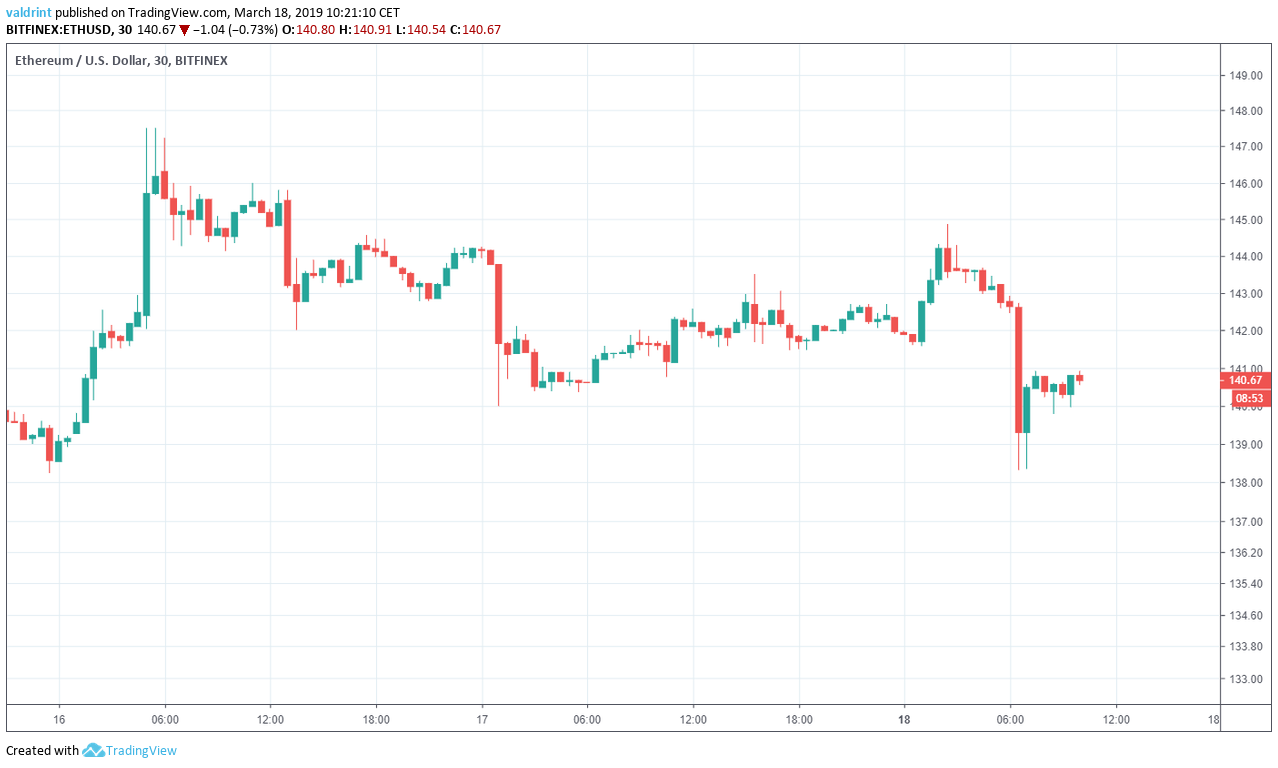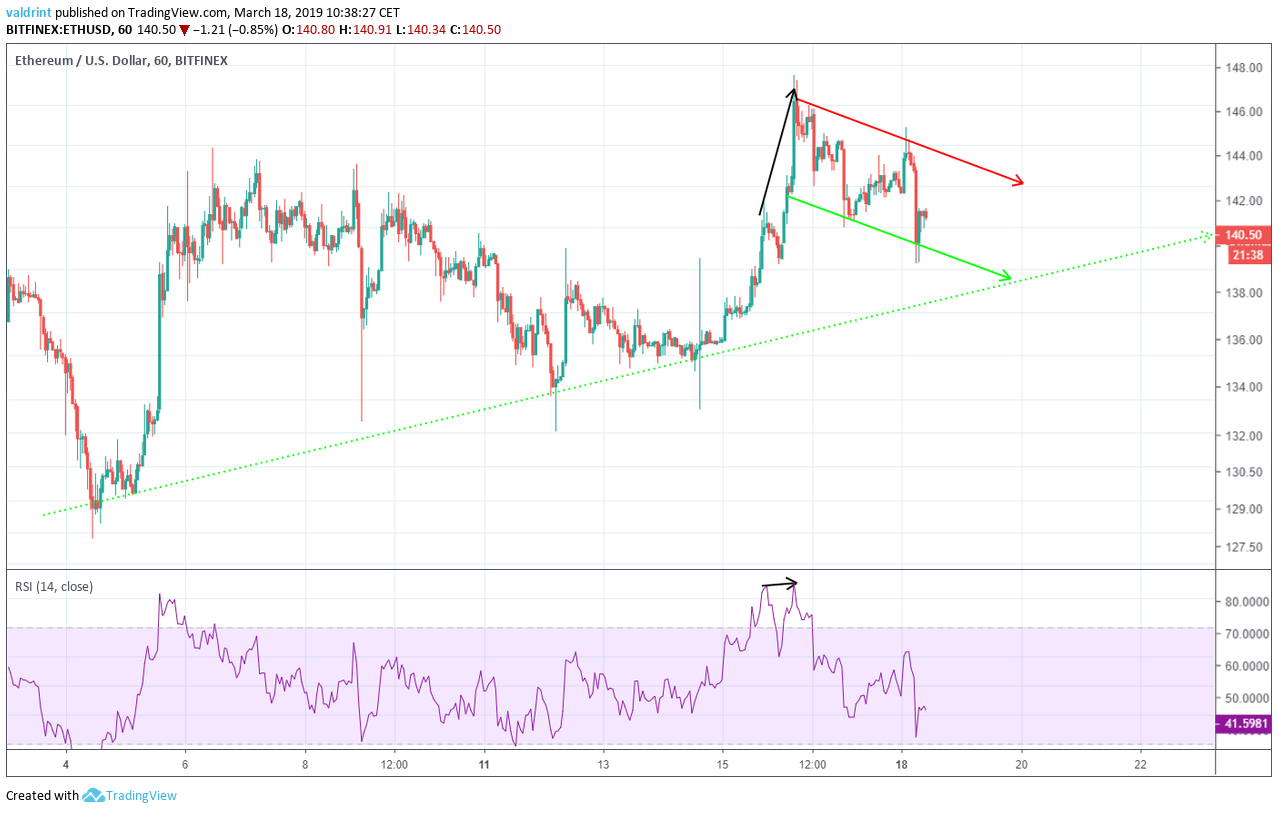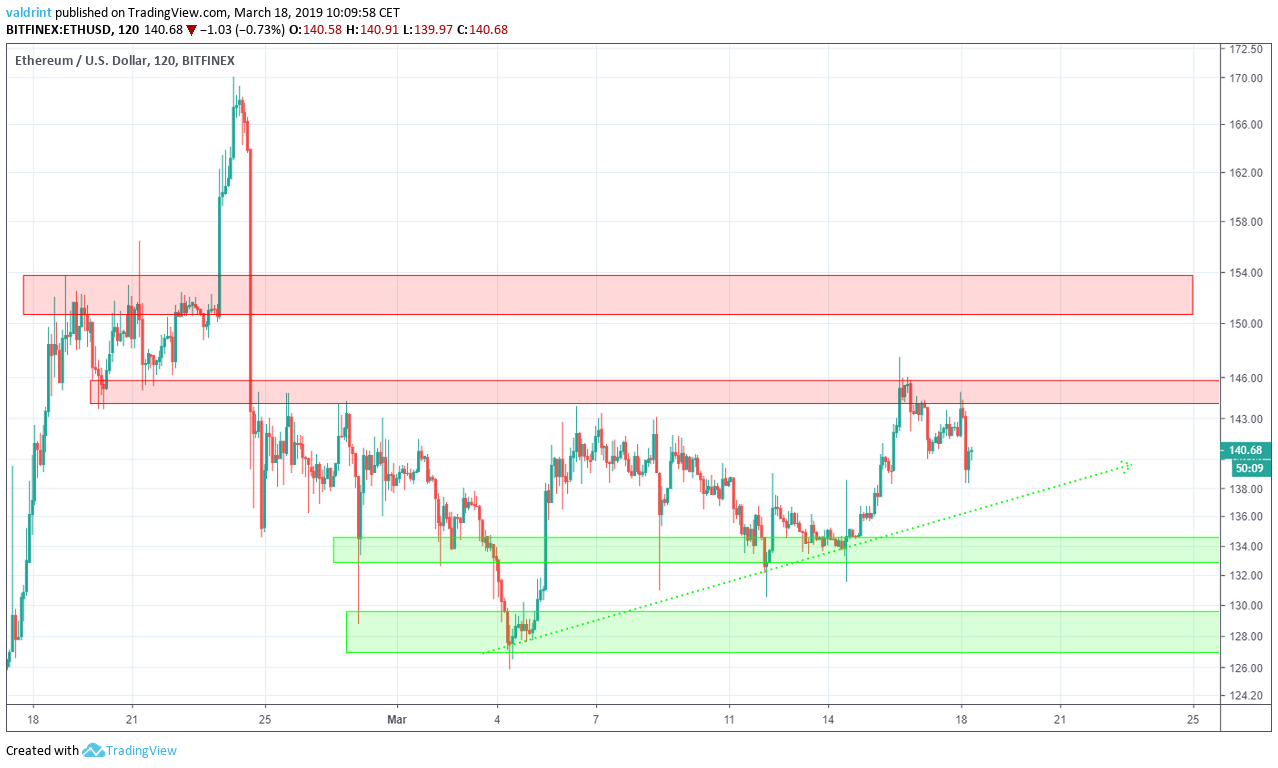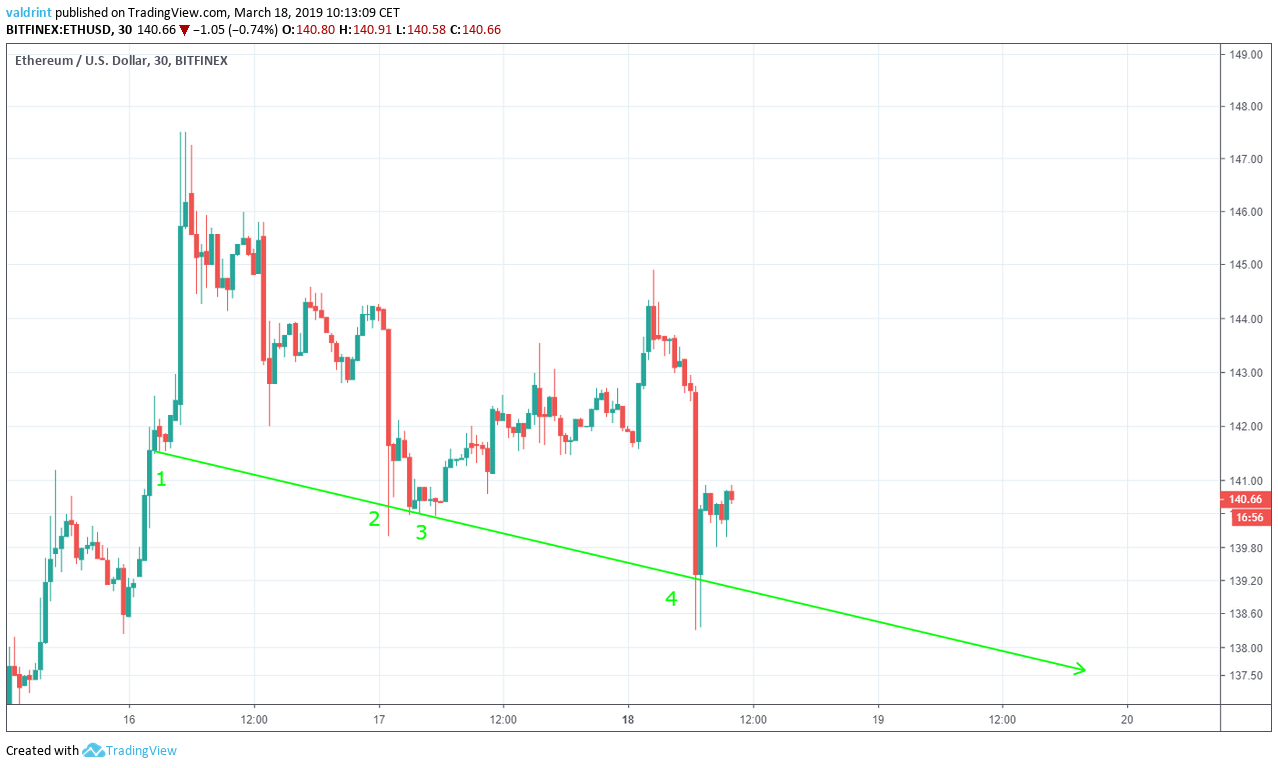On Mar 16, 2019, Ethereum (ETH) reached a high of nearly $148. It has been on a gradual downtrend since. When will the prices stop falling? Keep reading, and we might just have an answer for you.
First, take a look at Ethereum’s prices between Mar 16 and 18:
 In our Mar 15 analysis of Ethereum, we predicted that a breakout would occur. We suggested that it take price above the $136 resistance level. The breakout occurred on Mar 16, and prices did rose to over $147—much higher than expected. Prices have since fallen to current levels fo $141.
Based on today’s analysis, we believe that a gradual decrease in the price of ETH is forthcoming. Once the bottom is reached, we are looking forward to another breakout. but that a breakout should eventually follow.
In our Mar 15 analysis of Ethereum, we predicted that a breakout would occur. We suggested that it take price above the $136 resistance level. The breakout occurred on Mar 16, and prices did rose to over $147—much higher than expected. Prices have since fallen to current levels fo $141.
Based on today’s analysis, we believe that a gradual decrease in the price of ETH is forthcoming. Once the bottom is reached, we are looking forward to another breakout. but that a breakout should eventually follow.
Key Highlights For March 18
- The price of Ethereum (ETH) has been on a downward trend since March 16.
- ETC has been trading inside a short-term descending channel.
- ETC has been following a long-term ascending support line.
- There are resistance areas near $153 and $145.
- There is a support area near $126.
- Bullish divergence appears to be developing.
Tracing Support
The price of ETH on Bitfinex was analyzed at thirty-minute intervals from Mar 16 to Mar 18. On Mar 16, the price of ETH reached a low of $141.51. A sharp upward move occurred, followed by a gradual decrease. Several market cycles were completed. Each dip was lower than the last. Tracing these lows gives us a descending support line.Descending Channel
After reaching the Mar 16 high of $147.5, a gradual decrease ensued. The price made another lower high. Tracing these highs gives us a descending resistance line. Similar to the support line, the resistance line can act as a ceiling to price. It should theoretically trace the upper limits of price over a period of time.
Breakdowns below the support line by a wick in a volatile market are relatively unimportant as long as they are
The support and resistance lines combine to create a parallel descending channel which is considered a neutral pattern. However, since the channel is trending downward, price decreases can be expected. Unfortunately, the current channel does not help us determine whether Ethereum’s price will move toward support or resistance. Price decreases and increases within the channel both appear possible.
Similar to the support line, the resistance line can act as a ceiling to price. It should theoretically trace the upper limits of price over a period of time.
Breakdowns below the support line by a wick in a volatile market are relatively unimportant as long as they are
The support and resistance lines combine to create a parallel descending channel which is considered a neutral pattern. However, since the channel is trending downward, price decreases can be expected. Unfortunately, the current channel does not help us determine whether Ethereum’s price will move toward support or resistance. Price decreases and increases within the channel both appear possible.
Ascending Support
The price of ETH on Bitfinex was analyzed at one-hour intervals from Mar 4 to Mar 18. This was done in order to visualize the longer price trend while attempting to infer the direction of Ethereum’s price over the short-term. To do this, we combine the relative strength index (RSI) bullish/bearish divergence with support/resistance essentially in an attempt to predict future price fluctuations. RSI is an indicator which calculates the size of the changes in price in order to determine oversold or overbought conditions in the market. The price made a low of $125.88 on Mar 4. Several market cycles have been completed since, with each dip being higher than the preceding one. Tracing these lows gives us an ascending support line. The support line can act as a floor to price, preventing further downward movement. The ascending support line coincides with the short-term support line in the previous descending channel.
The price made a high of $141.19 on Mar 15. On Mar 16, it made another high of $147.5
Similarly, the RSI made the first high on Mar 15. However, it did not make another high. On the contrary, it reached but did not exceed the same level on Mar 16.
This is called bearish divergence and often precedes drops in price.
Based on this pattern and indicator, the price is likely to decrease at the rate predicted by the short-term descending channel until it touches the ascending support line. A breakout is then likely to follow.
The support line can act as a floor to price, preventing further downward movement. The ascending support line coincides with the short-term support line in the previous descending channel.
The price made a high of $141.19 on Mar 15. On Mar 16, it made another high of $147.5
Similarly, the RSI made the first high on Mar 15. However, it did not make another high. On the contrary, it reached but did not exceed the same level on Mar 16.
This is called bearish divergence and often precedes drops in price.
Based on this pattern and indicator, the price is likely to decrease at the rate predicted by the short-term descending channel until it touches the ascending support line. A breakout is then likely to follow.
Resistance and Support Areas
The price of ETH on Bitfinex was analyzed at two-hour intervals from Feb 18 to Mar 18 to determine possible future resistance and support areas. Resistance and support areas are created when the price revisits the same level several times. The first resistance area is located near $145. Ethereum recently rejected this price on Mar 15. A second resistance area is found near $153. If the price were to break out of the channel, these two would provide likely reversal areas. This means that a sudden breakout above the resistance line may lead to prices of $144 or $153.
The closest support area is found near $133, with the second being found at $128. According to our analysis, it is unlikely that the price will reach this level in the near future.
The first resistance area is located near $145. Ethereum recently rejected this price on Mar 15. A second resistance area is found near $153. If the price were to break out of the channel, these two would provide likely reversal areas. This means that a sudden breakout above the resistance line may lead to prices of $144 or $153.
The closest support area is found near $133, with the second being found at $128. According to our analysis, it is unlikely that the price will reach this level in the near future.
Summary of Analysis
Based on this analysis, the price of ETH is likely to keep trading inside the descending channel until a breakout occurs. Price decreases should continue until it touches the ascending support line. If this occurs before an upward movement out of the channel, the prediction will be fully validated. If there is a breakout without further price decreases, the prediction will be partially validated. If the prices decrease steadily and breakdown below resistance, the prediction would be invalidated. Do you think that we’ll see another breakout for Ethereum? When do you think that this will occur? Let us know your thoughts in the comments below. Disclaimer: This article is not trading advice and should not be construed as such. Always consult a trained financial professional before investing in cryptocurrencies, as the market is particularly volatile.Disclaimer
In line with the Trust Project guidelines, this price analysis article is for informational purposes only and should not be considered financial or investment advice. BeInCrypto is committed to accurate, unbiased reporting, but market conditions are subject to change without notice. Always conduct your own research and consult with a professional before making any financial decisions. Please note that our Terms and Conditions, Privacy Policy, and Disclaimers have been updated.

Valdrin Tahiri
Valdrin discovered cryptocurrencies while he was getting his MSc in Financial Markets from the Barcelona School of Economics. Shortly after graduating, he began writing for several different cryptocurrency related websites as a freelancer before eventually taking on the role of BeInCrypto's Senior Analyst.
(I do not have a discord and will not contact you first there. Beware of scammers)
Valdrin discovered cryptocurrencies while he was getting his MSc in Financial Markets from the Barcelona School of Economics. Shortly after graduating, he began writing for several different cryptocurrency related websites as a freelancer before eventually taking on the role of BeInCrypto's Senior Analyst.
(I do not have a discord and will not contact you first there. Beware of scammers)
READ FULL BIO
Sponsored
Sponsored

